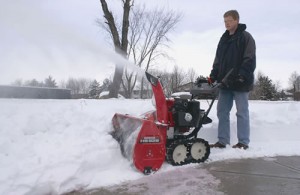 Honda’s durable snowblowers are built to last, but regular maintenance can ensure that common issues and pitfalls are avoided. By paying attention to things like oil levels, transmission fluid requirements, spark plug integrity, and many other areas of the equipment, snowblower owners will enjoy more efficient operation and fewer long-term operating and service expenses. Here’s what to know when maintaining the Honda HS928 and keeping its many moving parts in a state of great repair.
Honda’s durable snowblowers are built to last, but regular maintenance can ensure that common issues and pitfalls are avoided. By paying attention to things like oil levels, transmission fluid requirements, spark plug integrity, and many other areas of the equipment, snowblower owners will enjoy more efficient operation and fewer long-term operating and service expenses. Here’s what to know when maintaining the Honda HS928 and keeping its many moving parts in a state of great repair.
1. Oil Checks, Changes, and More
Oil levels should be checked before each use of the Honda snowblower, since an extended period of time outdoors can sometimes deplete oil stores and lead to engine problems. Furthermore, oil leaks will be easier to find and more affordable to fix if they’re caught early. In addition to regular oil checks each time the equipment must be used to clear snow, Honda recommends regular oil changes in order to keep the equipment running in peak condition. New snowblowers must have a full oil change after their first 20 hours of operation. After that initial oil change, Honda recommends repeating the process at least once every 100 hours. This typically occurs every one or two months in bad winters, or once a season during milder winter months.
When checking or changing the oil, Honda always recommends operators supplement or replace the fluid with an approved 5W-30 formulation. This oil is easily the best possible option for a piece of equipment that regularly endures freezing temperatures, and it’s the best way to keep the engine running smoothly and efficiently over the long-term.
3. Transmission Fluid Considerations
Transmission fluid is measured using a dipstick that has indicators for both “high” and “low” fluid levels. Generally, this is designed to work best when the snowblower and transmission fluid are both at room temperature. In this ideal circumstance, the fluid would measure about midway between the two extremes. If the engine is hot and was recently used, transmission fluid likely will reach the “high” mark on the dipstick. This is normal and should not be cause for concern. In colder weather, transmission fluid may reach the “low” level indicator.
IF transmission fluid is below the “low” level on the dipstick, or if its level is too low for the cold temperatures outdoors as noted in the Honda user manual, new fluid should be added. Honda recommends using only the company’s own Honda Hydrostatic Transmission fluid for best results. This fluid can be easily found at most authorized Honda dealers and service centers.
3. Spark Plug
The spark plug should be checked before each use of the Honda HS928 snowblower. If any carbon deposits are present, or if dirt has built up around the spark plug, go ahead and clean the equipment prior to turning on the snowblower. Additionally, be sure to check the spark plug electrode’s overall distance from the engine and verify that the spark plug itself is not cracked, bent, or otherwise damaged from the rigors of regular snowblower operation.
If the spark plug shows any signs of damage or excessive wear, it should be replaced immediately. This should occur before the snowblower is used at all. As always, an OEM Honda spark plug is the best choice for perfect compatibility and long-term durability in even the most challenging conditions.
4. Track Adjustment
Track adjustment can make a real difference when clearing snow accurately and efficiently, even in deeper accumulations. Generally, the appropriate track deflection reading is taken when a total downward force of 33 pound-feet is applied to the track. At that point, operators should take a measurement that should fall between 1-1/16 inches and 1-5/16 inches. If the deflection measurement is greater or less than these ideal numbers, tighten the tracks until they give the proper reading for best operation.
5. Tire Inspection
Always check the tires before use, since significant damage to either the treads or side wall can cause tires to crack, burst, and potentially inflict injury during snow clearing. If tires show any significant signs of wear and tear prior to clearing snow, operators should put off their work until the tires have been properly repaired or replaced and the snowblower is once again safe to operate.
6. Skid Shoes and Scraper
The ideal thickness for snowblower skid shoes, at least in terms of the Honda HS928, is 0.02 inches. If the skid shoes measure any thinner than this, they should be rotated so that the unused, top part of the equipment touches the ground during operation. If both sides have been used, OEM Honda skid shoes should be purchased new and placed onto the equipment before the next snow clearing task is required.
Additionally, the scraper should always be checked and adjusted prior to use. Different ideal scraper heights exist for different kinds of snow and difference surfaces where the snowblower will be used. Consult the Honda user guide to learn more about the ideal positioning of the scraper according to surface type and snow depth.
HondaLawnParts.com Has the OEM Parts That Operators Need
When the time has come to replace scrapers, skid shoes, tires, or other parts of the equipment, HondaLawnParts.com is a great resource. The online parts lookup tool can recommend the proper OEM Honda parts according to snowblower model number, engine type, and part number. That makes it easy to stay in line with seasonal maintenance requirements and enjoy efficient snow clearing until the spring thaw.
